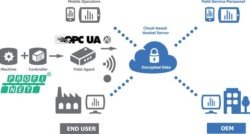Being in the business of moving data with PROFINET, references to the data-driven factory* appeal to me. Appealing as that is, it’s an incomplete story. Like a word-driven blog post. Random words collected do not a blog post make. Random data collected does not a factory drive. Data is the raw material. Turning it into useful information that can be acted upon is the challenge. Fortunately, PROFINET provides a good start in meeting that challenge. First of all, PROFINET delivers more than bits and bytes, coils and registers; it delivers values in engineering units, the engineering units, quality information, and more. Furthermore, those values and other attributes can be arranged in objects (we call them application profiles). For example, drives are used in most automation projects and we have a PROFIdrive object that arranges information in a vendor-neutral way. Instead of researching all drive values names and locations for each brand of drive, just use PROFIdrive.
But what if the data is not accessible? What happened? PROFINET provides comprehensive diagnostic information from individual channels so can report “motor start output has a broken wire,” for example, to network status. Maximizing uptime is a benefit of PROFINET derived from diagnostics and redundancy of networks, devices, and controllers.
So PROFINET gets “data” to controllers, but that’s not the end of the journey to a data-driven factory. Once in the controller, additional manipulation takes place; like, “conditions are met to start the motor.” From the controller up, PROFINET partners with OPC UA. OPC UA is designed to securely amalgamate the data into information and deliver it to HMIs, historians, and analytics. Then the feedback loop can be completed and action taken to improve the production process.
–Carl Henning
*The data-driven factory fits in the concept of Industrial Internet of Things (IIoT), Industrie 4.0, and the PROFINET of Things.

